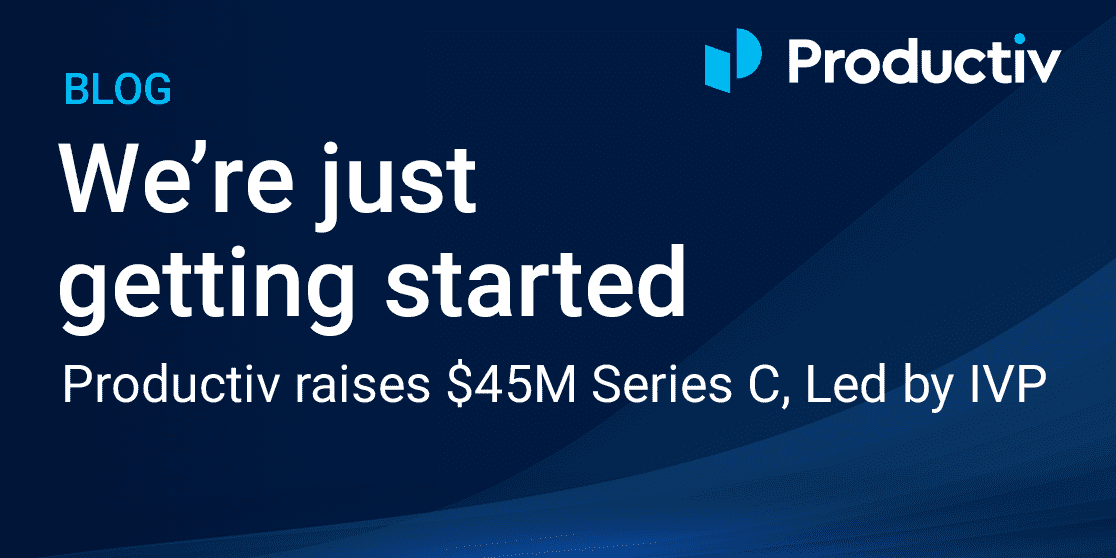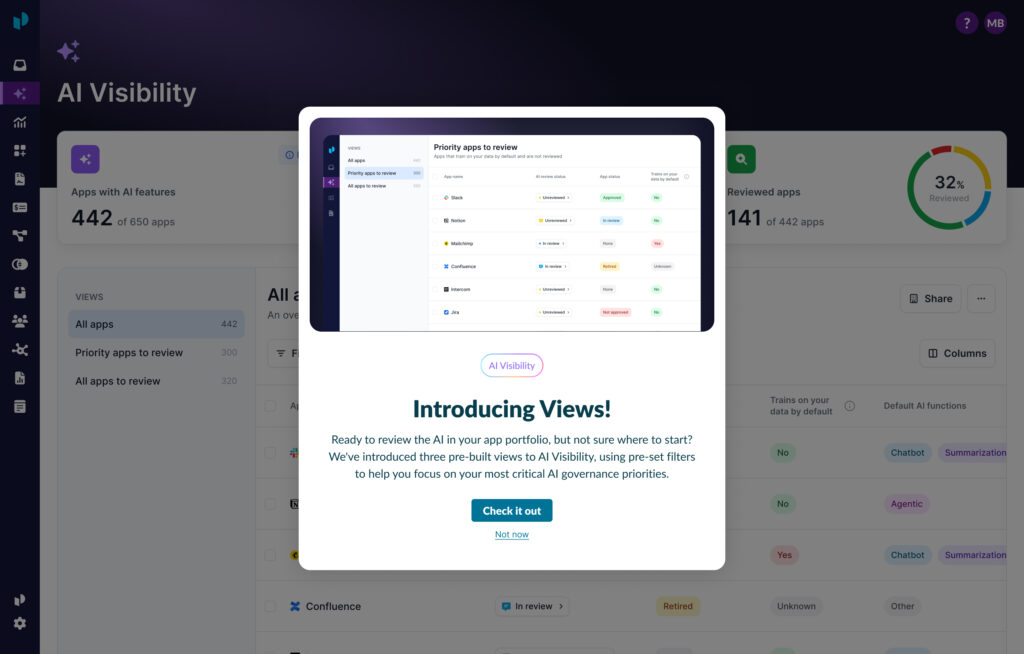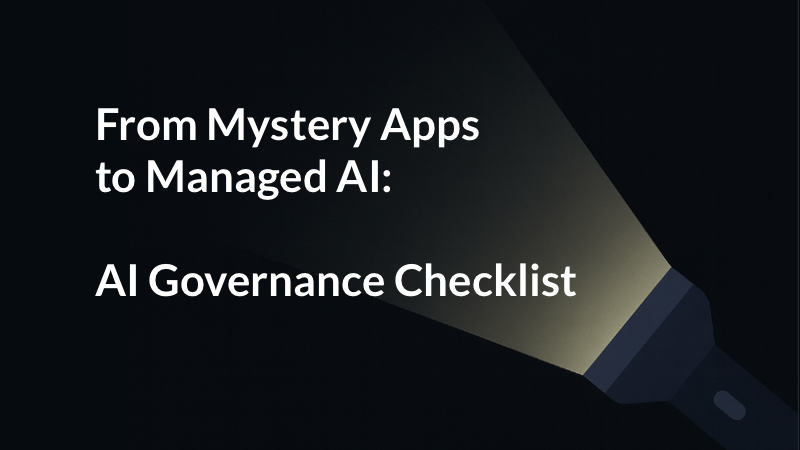
We’re just getting started: Productiv raises $45M Series C, led by IVP
Today we’re excited to announce a Series C investment of $45M led by IVP with additional investment from new investor Atlassian Ventures and existing investors Accel, Norwest Venture Partners, and Okta Ventures. We’re thrilled to announce IVP’s bet on us alongside customers like Dolby, Square, Equifax, Unity, Zoom, GlobalLogic, and Uber who have chosen Productiv to tackle their SaaS management needs.
Prior to founding Productiv with my incredible co-founders, Munish and Ashish, I led Google Analytics and built its enterprise business. While in that role, I witnessed firsthand how CMOs were forever transformed by the quantification of their efforts vis-à-vis tools like Google Analytics, and yet, marveled that nothing like this exists for CIOs. Why can we measure everything about the customer journey but have so little insight into the employee software experience and the use of technology in our own businesses?
Companies spend enormous amounts providing people with the tools they need to get their work done—more than $10,000 per employee annually—but these are open-loop investments without data to show how business value is delivered. Are people becoming more productive at work? Do they have the right tools? Do the tools work well together? Can people collaborate easily? These are challenging analytics questions, especially given that the data you need to answer them is scattered across hundreds of SaaS tools.
Furthermore, the sheer number of vendors to negotiate contracts with, confirm are secure and compliant, and ensure are delivering value is immense and still climbing, presenting a growing challenge for IT teams to keep up with. And yet, what tools do IT teams typically rely on today to manage this chaos? The humble spreadsheet.
This just won’t do.
When we think about what powers organizations, it is fundamentally technology that interconnects us and makes work possible. If you had any doubt about the way work has changed to revolve around technology, think about the abrupt shift to work from home that the world took during the global COVID pandemic. The vast majority of technology adoption is of SaaS software, available via the internet and accessed as easily at home as you would in the office. This market today is already estimated at $100-150B and it’s still growing like crazy.
SaaS is the medium within which so much of the economic activity of the world today exists. SaaS is how we collaborate, it’s increasingly the products that we sell, and it’s where we often store our data. Frictions in how SaaS is used, purchased, and secured impact all of us—not just software companies, but all companies.
What would it mean to conceive of dramatically different ways to use data to improve each of these categories?
Collaboration across all of your SaaS
There is a new norm for vendor selection where employees pick and choose the tools they use rather than just what IT tells them they must. In a world where there are more choices than ever, with easy accessibility, it’s no wonder employees choose the path of least resistance and focus first on meeting their needs without considering things important to IT like security, compliance, and standardization.
Organizations need insight into what works and doesn’t work. What do our employees love and what is redundant? How do we get the most out of the technology we’re using and ensure that teams are working together? We need to ensure productivity is maintained in this fluid and evolving environment.
Right now there is a many-to-many model where vendors must integrate with each other to function as a tech stack to the end user; however no single vendor can see the totality of the system within which they operate. Until now, there’s been no way to measure the effectiveness of collaboration across the organization with insight into how each team works with every piece of software. Without a comprehensive view of your entire SaaS investment, how can you bring all of these disparate pieces together and achieve what might be possible in the realm of collaboration, productivity, and deeply-integrated, seamless experiences?
Creating a shared view for buyers and sellers
When it comes to the purchase of new software, the conversation usually starts with a business case that identifies a fair value for the service and the benefits the customer expects to realize. Over the course of the relationship, vendors and customers should work together to ensure that value is delivered and new customers become happy and loyal customers.
The challenge is that we would like to have better insight into the value created for customers. Vendors need a better way to understand how users are interacting with their products, in the context of the tech stack of the organization, while customers realize better value when they can zero in on adoption, usage, and business outcomes.
From the kickoff conversation to the time of renewal, there should be a shared view of value created; a way for both vendors and customers to hold each other accountable for the success of deployment, enablement, adoption, and feedback. When the relationship between vendors and customers presents more opportunities for collaboration and value expansion, both parties benefit. Imagine quarterly business reviews where value realization strategy discussions are backed with robust engagement, collaboration, and sentiment data. This data is available and real-time today, creating opportunities to expand these aligned relationships.
Scalable security in the age of SaaS and shadow IT
The number of SaaS apps in organizations is increasing in a trend that has no foreseeable end. Shadow IT, as a major driver of this growth, is especially concerning because of its ability to put your organization at risk without your explicit knowledge, jeopardizing SOC 2, GDPR, HIPAA, and other meaningful compliance standards that protect your organization and its customers. But what if you could embrace a philosophy of distributed innovation without the risks that “shadow IT” conjures?
Keeping your organization safe and compliant should be easy and not the Damocles’ sword that exists today, where the threat of a catastrophic data breach seems possible for virtually any company. Progressive CIOs understand that maintaining security and compliance does not have to come at the expense of hampering the bold employees who innovate, experiment, and adopt new tools on behalf of the organization.
The path forward seeks to reduce risk in a systematic fashion—using a scalable solution to a rapidly scaling problem. We believe that a comprehensive grasp of your SaaS portfolio—integrated with your security compliance policies—will help to eliminate one critical vector of security concern. And if things do go wrong, that you have a starting point to respond to incidents and quickly bring resolution. We believe that with the right tools, we can enable innovation while still fulfilling our roles as guardians of security and risk mitigation.
The journey forward
We’re solving a problem that every company faces today: an explosion in the number of SaaS applications deployed in organizations, many of which are unknown to IT. Managing the entire SaaS portfolio used to be overwhelmingly complicated at scale. But this is no longer true.
Securing, provisioning, and renewing apps can be easier. We have the capacity to more accurately understand and work with vendors on value delivered. And more importantly, we now have insight into collaboration and productivity in the organization, unlocking new transformational opportunities led by IT. This is all made possible via data, analytics, workflows, and automation, and that’s what we do at Productiv.
Thank you to our customers, IVP, Accel, Norwest Venture Partners, and our team at Productiv.
We at Productiv are on a journey to transform how you think about SaaS and the impact it can have on your organization. And we’re just getting started.
About Productiv:
Productiv is the IT operating system to manage your entire SaaS and AI ecosystem. It centralizes visibility into your tech stack, so CIOs and IT leaders can confidently set strategy, optimize renewals, and empower employees.





